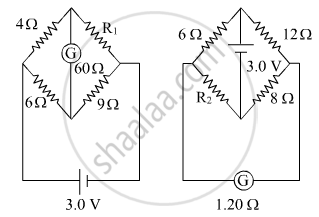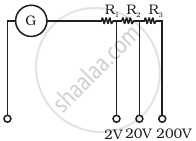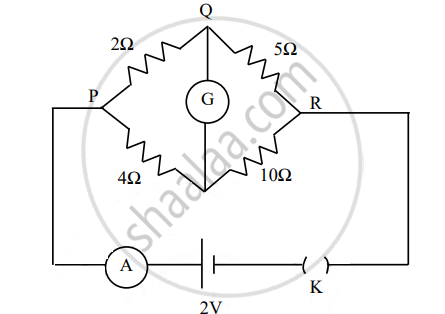Advertisements
Advertisements
प्रश्न
An ideal voltmeter has _______.
(A) low resistance
(b) high resistance
(C) infinite resistance
(D) zero resistance
उत्तर
(c) Infinite resistance
APPEARS IN
संबंधित प्रश्न
The combined resistance of a galvanometer of resistance 500Ω and its shunt is 21Ω. Calculate the value of shunt.
A rectangular coil of a moving coil galvanometer contains 50 turns each having area 12 cm2 . It is suspended in radial magnetic field 0.025 Wb/m2 by a fibre of twist constant 15 x10-10 Nm/degree. Calculate the sensitivity of the moving coil galvanometer.
Show that the current flowing through a moving coil galvanometer is directly proportional to the angle of deflection of coil.
Write the underlying principle of a moving coil galvanometer.
Why does a galvanometer show a momentary deflection at the time of charging or discharging a capacitor? Write the necessary expression to explain this observation.
Obtain the expression for current sensitivity of moving coil galvanometer.
A circular coil of 250 turns and diameter 18 cm carries a current of 12A. What is the magnitude of magnetic moment associated with the coil?
Draw a labelled diagram of a moving coil galvanometer. Describe briefly its principle and working.
Increasing the current sensitivity of a galvanometer may not necessarily increase its voltage sensitivity. Explain, giving reason.
Two moving coil meters, M1 and M2 have the following particulars:
R1 = 10 Ω, N1 = 30,
A1 = 3.6 × 10–3 m2, B1 = 0.25 T
R2 = 14 Ω, N2 = 42,
A2 = 1.8 × 10–3 m2, B2 = 0.50 T
(The spring constants are identical for the two meters).
Determine the ratio of
- current sensitivity and
- voltage sensitivity of M2 and M1.
- A circular coil of 30 turns and radius 8.0 cm carrying a current of 6.0 A is suspended vertically in a uniform horizontal magnetic field of magnitude 1.0 T. The field lines make an angle of 60° with the normal of the coil. Calculate the magnitude of the counter torque that must be applied to prevent the coil from turning.
- Would your answer change, if the circular coil in (a) were replaced by a planar coil of some irregular shape that encloses the same area? (All other particulars are also unaltered.)
A galvanometer has a resistance of 16Ω. It shows full scale deflection, when a current of 20 mA is passed through it. The only shunt resistance available is 0.06 which is not appropriate to convert a galvanometer into an ammeter. How much resistance should be connected in series with the coil of galvanometer, so that the range of ammeter is 8 A?
Why is it necessary to introduce a radial magnetic field inside the coil of a galvanometer?
How will you convert a moving coil galvanometer into a voltmeter?
With the help of a neat and labelled diagram, explain the principle and working of a moving coil galvanometer ?
Define current sensitivity of a galvanometer.
Figure shows two circuits each having a galvanometer and a battery of 3V.
When the galvanometers in each arrangement do not show any deflection, obtain the ratio R1/R2.

In the meter bridge experiment, balance point was observed at J with AJ = l.
(i) The values of R and X were doubled and then interchanged. What would be the new position of balance point?
(ii) If the galvanometer and battery are interchanged at the balance position, how will the alance point get affected?

State the principle of the working of a moving coil galvanometer, giving its labeled diagram ?
What are the advantages of using soft iron as a core, instead of steel, in the coils of galvanometers?
State how a moving coil galvanometer can be converted into an ammeter.
Define the term 'current sensitivity' of a moving coil galvanometer.
A galvanometer coil has a resistance of 12 Ω and the metre shows full scale deflection for a current of 3 mA. How will you convert the metre into a voltmeter of range 0 to 18 V?
A galvanometer coil has a resistance of 15 Ω and the metre shows full scale deflection for a current of 4 mA. How will you convert the metre into an ammeter of range 0 to 6 A?
The deflection in a moving coil galvanometer is ______.
The conversion of a moving coil galvanometer into a voltmeter is done by ______.
The coil of a moving coil galvanometer is wound over a metal frame in order to ______.
A galvanometer of resistance 100 Ω gives a full-scale deflection for a current of 10−5 A. To convert it into an ammeter capable of measuring up to 1 A we should connect a resistance of ______.
A galvanometer having a coil resistance of 60 Ω shows full-scale deflection when a current of 1.0 amp passes through it. It can be converted into an ammeter to read currents up to 5.0 amp by:
In an ammeter 0.5% of main current passes through galvanometer; If resistance of galvanometer is G, the resistance of ammeter will be.
The coil of galvanometer consists of 100 turns and effective area of 1 square cm. The restoring couple is 10-8 N-m/rad. The magnetic field between the pole pieces is 5T. The current sensitivity of this galvanometer will be ______.
A multirange voltmeter can be constructed by using a galvanometer circuit as shown in figure. We want to construct a voltmeter that can measure 2V, 20V and 200V using a galvanometer of resistance 10Ω and that produces maximum deflection for current of 1 mA. Find R1, R2 and R3 that have to be used.

A galvanometer coil bas 500 turns and each tum has an average area of 3 × 10-4 m2. If a torque of 1.5 Nm is required to keep this coil parallel to a magnetic field when a current of 0.5 A is flowing through it, the strength of the field (in T) is ______.
A galvanometer having a resistance of 20 Ω and 30 Ω division on both sides has figure of merit 0.005 ampere/division. The resistance that should be connected in series such that it can be used as a voltmeter upto 15 volt, is ______.
A moving coil galvanometer has 150 equal divisions. Its current sensitivity is 10-divisions per milliampere and voltage sensitivity is 2 divisions per millivolt. In order that each division reads 1 volt, the resistance in ohms needed to be connected in series with the coil will be ______.
How is current sensitivity increased?
Explain in brief the basic construction of a moving-coil table galvanometer whit a neat labelled diagram.
A voltmeter has a range of 0 - 20 V and a resistance of 500 Q. Explain how can be used to measure voltages from 0 - 200 volt?
A moving coil galvanometer of resistance 55 Ω produces a full scale deflection for a current of 250 mA. How will you convert it into an ammeter with a range of 0 - 3A?
Assertion: When an electric current is passed through a moving coil galvanometer, its coil gets deflected.
Reason: A circular coil produces a uniform magnetic field around itself when an electric current is passed through it.
The figure below shows a circuit containing an ammeter A, a galvanometer G and a plug key K. When the key is closed:

